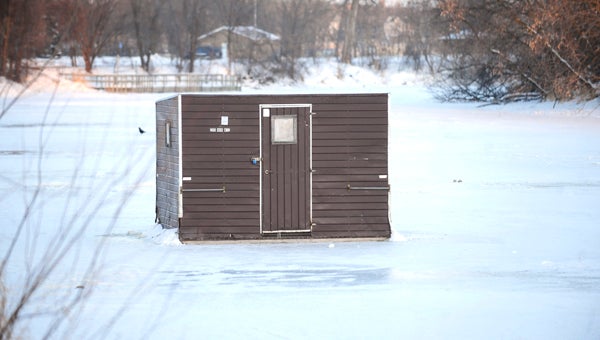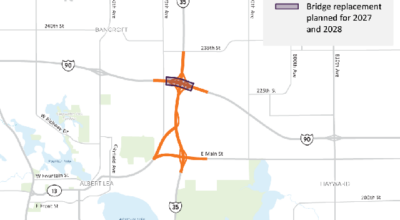DNR advises fishermen
Published 8:59 am Wednesday, December 26, 2012

A fish house sits on Albert Lea Lake this morning. The house properly displays the nine-digit DNR number to the left of the door. --Brandi Hagen/Albert Lea Tribune
All fish shelters must have proper ID
Ice conditions on Minnesota waterways may vary, but all fish shelters must have proper identification, according to conservation officers with the Minnesota Department of Natural Resources.
According to a press release, the DNR said ice anglers and others who place shelters on the ice of Minnesota waters must have either the owner’s complete name and address, a driver’s license number, or the nine-digit DNR number on the license of the owner plainly and legibly displayed on the outside of the shelter, in letters and figures at least two inches high.
Other shelter regulations
Shelters may not be left unattended any time between midnight and one hour prior to sunrise unless the shelter is licensed.
Trailers used to haul fish houses or dark houses and enclosed trailers or recreational trailers used for fishing must be registered. Trailer registration is available from a deputy registrar.
A tag, furnished with a license, must be attached to the exterior of the shelter in a visible location.
Shelters left on the ice overnight need to have at least two square inches of reflective material on each side of the house.
People may not erect a shelter within 10 feet of an existing shelter.
A shelter license is not required on border waters with Wisconsin, Iowa, North Dakota and South Dakota.
Shelters must comply with the identification requirements of the state in which angler is licensed.
Shelters may be used for fishing within the Boundary Waters Canoe Area Wilderness, but must be removed from the ice each night. The structure must be removed from the Boundary Waters each time the occupant leaves.
Shelter owners are also reminded to take appropriate steps to keep their houses from freezing onto ice surfaces. With seasonal thawing and cooling, it is not uncommon for shelter contact points to become frozen to the ice, providing challenges when it comes to moving or removing the shelters. A common method used to prevent freezing is to place blocks under the shelter contact points.
Ice anglers are reminded that blocks placed under shelters must be removed and cannot be left on frozen waters. An easy way to remove a frozen ice block is with a long handled maul or a splitting maul. A couple of clean strikes will easily free frozen blocks.
Anglers should review bait regulations
In a recent press release, the Minnesota Department of Natural Resources urged anglers who fish with frozen or imported dead bait to review regulations that govern the use of emerald shiners, spottail shiners, bluntnose minnows and other popular baitfish that are susceptible to the fish-killing disease viral hemmorhagic septicemia.
“In an effort to prevent the spread of VHS in Minnesota waters, additional regulations went into effect in the spring of 2012 that address the harvest and use of VHS susceptible species as frozen bait,” Paula Phelps, DNR aquaculture and fish health consultant said. “VHS is a highly contagious and pathogenic fish virus emerging in the Great Lakes region of the United States and Canada.”
Anglers purchasing dead or frozen disease susceptible or imported bait from a vendor should only purchase packages affixed with a label stating that the bait will not pose a threat of viral hemmorhagic septicemia to Minnesota waters. Anglers are required to keep the label with the bait until it is used up or discarded.
It is illegal for anyone to bring live bait into the state at any time.
Nonresident anglers need to be aware of the rules and either buy bait when they get to their fishing destination or ensure that their imported dead bait is affixed with the required label.
“Minnesota offers some of the best fishing in the nation,” Phelps said. “Anglers can help keep it that way by complying with the rules that prevent the spread of fish disease. With VHS present in the Great Lakes, especially Lake Superior, preventing inland spread is a high priority.”
The DNR also reminded anglers that when ice fishing, portable bait containers (except on waters designated infested with viral hemmorhagic septicemia) are no longer required to be drained before leaving the waterbody as is required during the open water seasons.
The most current list of designated infested waters can be viewed online at www.mndnr.gov/ais.
Information about the disease is available at www.focusonfishhealth.org.
More information on bait rules and regulations can be found in the 2012 Minnesota Fishing Regulations booklet or by visiting www.mndnr.gov/regulations.





